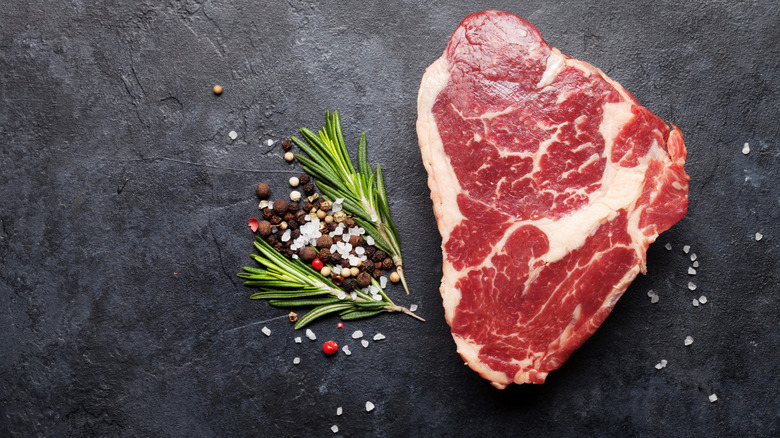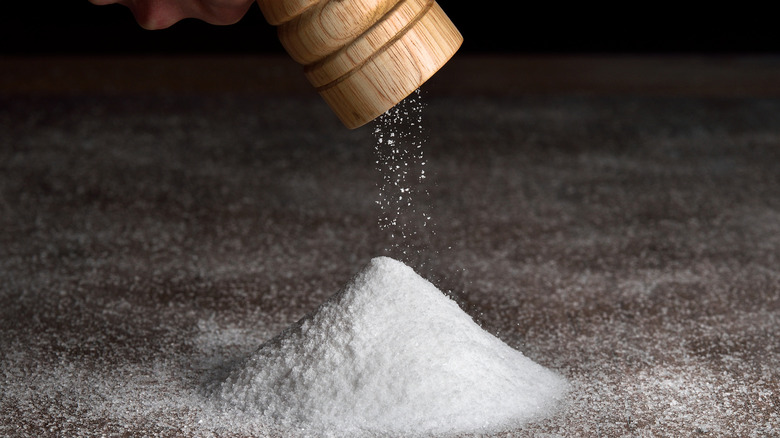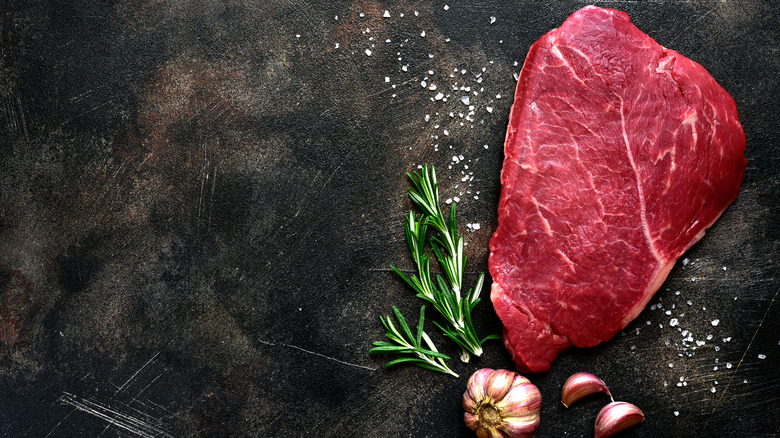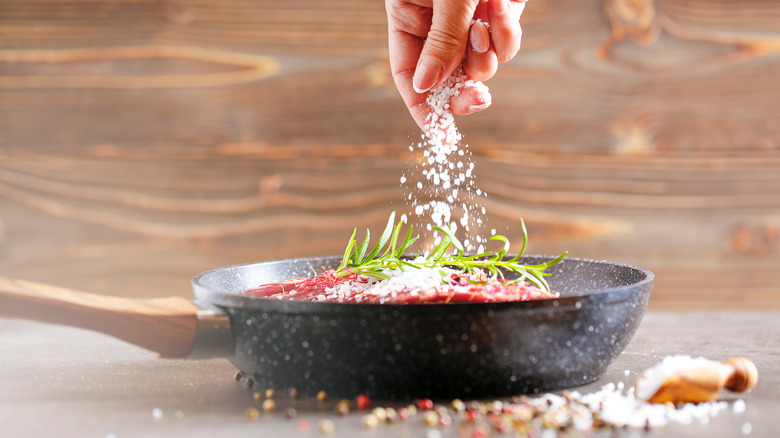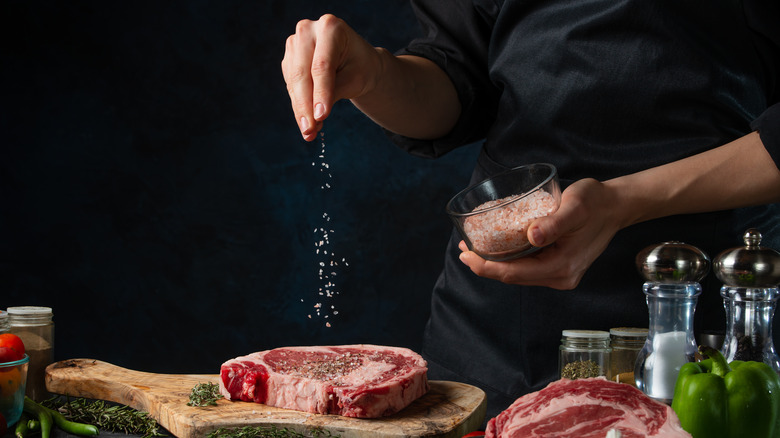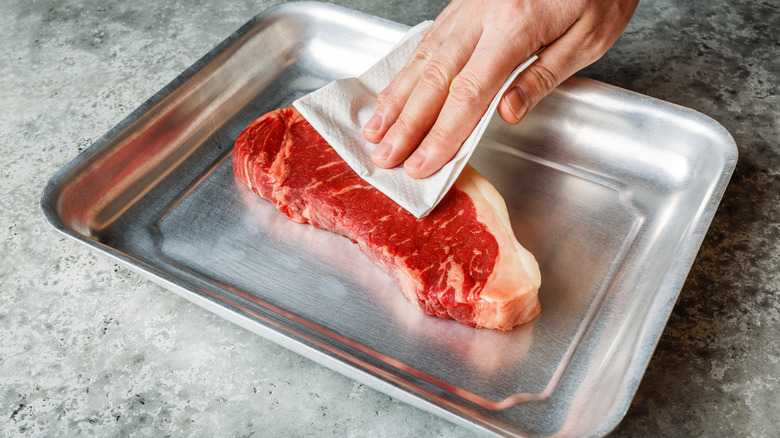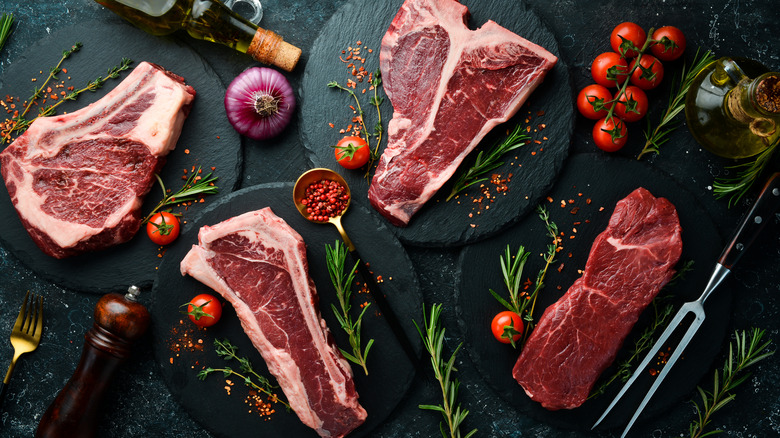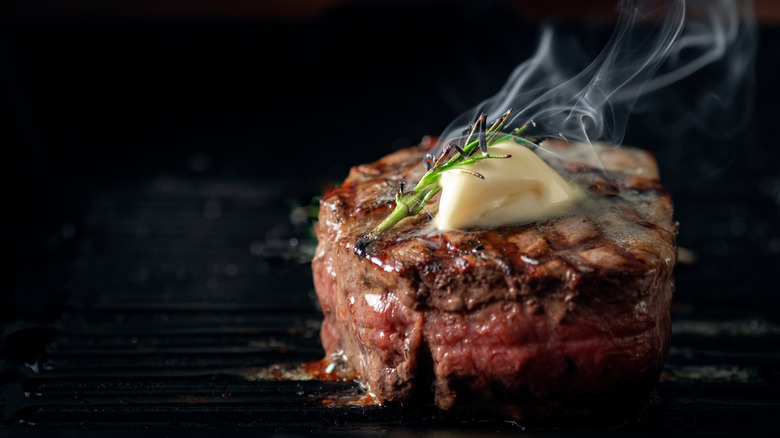7 Mistakes Everyone Makes When Seasoning Steaks
Cooking steaks at home can seem simultaneously very simple and very complicated. While most cuts of steak don't require a ton of seasoning to taste great, the quest to achieve that restaurant-quality seared perfection can still be daunting. You don't have to buy the most expensive cut of meat or own the fanciest grill on the market to make a great piece of steak at home, but you do need to make sure you season and prepare the steak the right way, since certain techniques can ultimately make or break the outcome of the final product on your plate.
At-home chefs tend to make some of the same repeated mistakes when seasoning beef before, during, and after its journey in the oven and on a grill or cast iron skillet, but a few simple tweaks are all that's needed to create a tastier meal. Keep reading to learn some common seasoning mistakes that happen when non-professional steak lovers are attempting to recreate the magic of their favorite steakhouse in their own kitchen.
Using the wrong kind of salt
Salt is the primary go-to accompaniment for steak. If you don't use any other seasoning and just salt the meat, you'd still probably have a great tasting piece of beef. However, the type of salt you use is just as important as the salt itself. Regular ol' super fine-grained table salt is not the ideal salt for seasoning steaks but people often use it because it's what they have in the pantry already.
Kosher salt is what most chefs universally recommend for steaks. The actual flakes in kosher salt are much thicker, and therefore cover the surface of the steak more efficiently. It's certainly easier to confirm you've seasoned the entire exterior of the steak when you can see the actual salt crystals. Always make sure to use kosher salt (any brand will do) if you're planning to cook your own steaks at home.
Using too little salt
When it comes to beef, it's essential to use salt liberally when seasoning, and it's usually a lot more salt than you might initially deem necessary. Pros know that If you want every bite to have flavor, especially when it's a thick cut of meat, be sure to aggressively salt every square inch of that steak. As The Spruce Eats points out, you aren't just eating the top part of the meat — the salt needs to coat every surface of the steak. This also helps form the crust like consistency of a supremely cooked steak. (Pepper, garlic, or other seasoning you might include doesn't need to encase the steak but definitely don't hold back when it comes to the salt.)
The exception to this rule of using a hefty amount of salt, per Steak School, is if you're cooking dry-aged steak. Because the process pulls moisture out of the meat, not as much salt is required when steaks are prepped with this method.
Seasoning the steak at the wrong time in the cooking process
There is some debate among steak fans regarding exactly when to season the meat. Some people advocate for seasoning just before cooking, while others propose seasoning the steak, then letting the steak sit the fridge up to a day or even two days before cooking. Otto Wilde recommends salting 40 minutes prior to cooking, again just before cooking, and right after cooking. Regardless which path you choose, there is one move you should absolutely avoid.
A common mistake, according to Oola, is letting the steak get to room temperature on the counter before seasoning it. Letting a piece of raw steak from the fridge reach room temperature with seasoning on it helps the meat to absorb all the seasoning's flavoring as it warms up. The result is a more supple final steak. Ideally, the route should be taking the steak out of the fridge, seasoning it, then letting it sit on the counter with the seasoning for at least 40 to 50 minutes before cooking (via Serious Eats).
We suggest that if you have the time, season the steak then place it in the fridge overnight. It's worth trying this method since the salt will have time to do its magic — initially draw moisture to the surface of the steak before that moisture absorbs the salt, then seeps back into the steak bringing the salt flavor with it. This is essentially dry-brining the steak, a popular seasoning technique.
Applying the seasoning incorrectly
Believe it or not, how you apply the salt (and other seasoning, if you're opting to use it) might be negatively impacting the outcome of your steak. Many times people cooking steaks at home don't take into consideration the technique they're using to apply their seasoning. If you want to ensure an even coating of salt (and trust us, you do), try to hold your hand about two feet above the piece of meat as you liberally sprinkle the salt onto it.
Then once the surface of the meat is fully coated in the salt, The Pioneer Woman recommends using your hands to press the salt flakes into the steak. The reasoning behind this is very simple and probably exactly what you'd assume — it helps the salt to stick to the meat. And remember to place the steak on a wire rack over a foil-lined sheet pan after seasoning so the air can fully circulate around the meat (via Serious Eats).
Not patting the steak dry before seasoning
If you are searing a steak at home and want that awesome, perfectly salty crust you expect from a restaurant steak, there is a simple tweak you can make prior to doing any of your seasoning. Do not make the mistake of skipping the part where you use a paper towel to pat the raw steak until it's dry before adding any seasoning to it.
The paper towel blotting technique is very simple to execute and might not seem like a necessary step, but it's essential for getting the best possible outcome with the cooked steak. Gently press the paper towel onto every inch of the meat so that it's completely dry before you add any of your seasoning, whether it's salt, pepper, or the ingredient of your choosing. While it's not necessary to wash the meat prior to cooking, there will still be moisture from the meat when you pull it out of the fridge to season it.
Not considering the cut of steak when seasoning
It's important to be cognizant of the cut of meat when you're deciding on the best way to season it, and very often people do not take this into account when they start the seasoning process. The main factor here is that some cuts might do better with an actual legit liquid marinade first, as opposed to ones that just need a sprinkling of dry ingredients, like salt and pepper.
The majority of steak cuts require little more than salt to season sufficiently (per The Kitchn). However, certain steaks, such as hanger, flank, or skirt, are inherently tougher and therefore, we advise that you marinate these cuts for four hours or even overnight prior to cooking. While a liquid marinade can technically be used for more tender cuts like ribeye, it definitely isn't required, and the use of a liquid marinade can overwhelm the flavor of the meat and decrease the potential for that nice browning of the steak in the cooking process.
Adding butter to the steak too soon
Butter is the secret ingredient to enhancing richness and flavor in a lot of high-quality restaurant steaks. But if you're going to employ this hack in your own kitchen, make sure you do it at the exact right time in the cooking process. Some folks might think you can slap some butter on prior to cooking the steak and get juicier results. According to KitchenSeer, the key is actually adding butter to the steak after it finishes cooking, then letting the meat rest a bit before serving. That resting period is a great time for the butter to melt over the top of the meat and yield a nice shiny sheen on the top.
If you try to cook the steak with butter on it, you can end up with a burnt-tasting steak because butter has a relatively low smoke point. If you really want to get wild, using a compound butter, which is basically butter mixed with other ingredients to give it flavor, is also an option for a flavorful steak.
